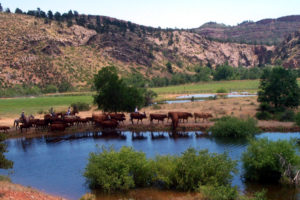Finishing cattle on grass is an art and science. Here’s where we swap stories about how to do it right.



 Here at Sylvan Dale we are using cattle to help build up organic matter and carbon content of our soils. The technique: planned, rapid rotation grazing. It turns out this also helps the soil conserve water. Here’s a post from Dr. Roy Roath, CSU Professor Emeritus, describing a grazing experiment he conducted on range land in Northern Colorado:
Here at Sylvan Dale we are using cattle to help build up organic matter and carbon content of our soils. The technique: planned, rapid rotation grazing. It turns out this also helps the soil conserve water. Here’s a post from Dr. Roy Roath, CSU Professor Emeritus, describing a grazing experiment he conducted on range land in Northern Colorado: